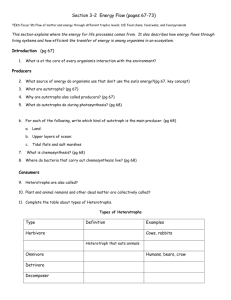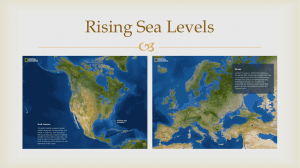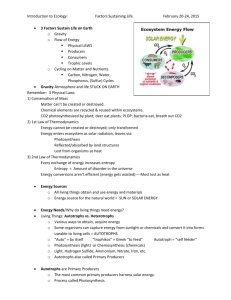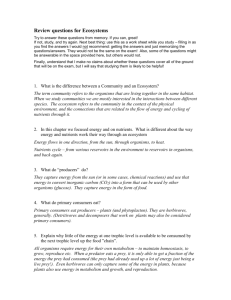Intro to Ecology ppt.
advertisement
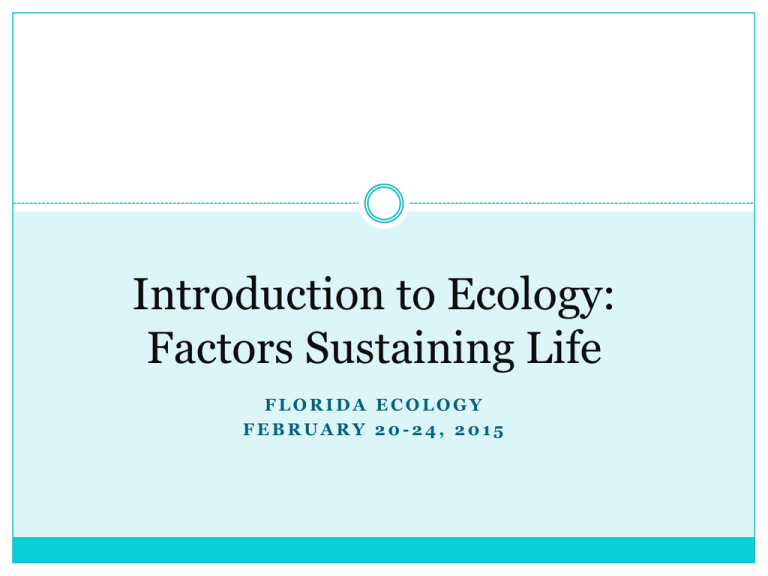
Introduction to Ecology: Factors Sustaining Life FLORIDA ECOLOGY FEBRUARY 20-24, 2015 Review Ecology Ecologist Ecosystem Environment = Abiotic + Biotic Factors Habitat Organism 3 Factors Sustain Life on Earth 1) Gravity 2) Flow of Energy Physical LAWS Producers Consumers Trophic Levels 3) Cycling of Matter and Nutrients Carbon, Nitrogen, Water, Phosphorus, (Sulfur) Cycles Gravity Atmosphere and life STUCK ON EARTH Remember: 3 Physical Laws 1) Conservation of Mass Matter can’t be created or destroyed Chemical elements are recycled & reused within ecosystems CO2 photosynthesized by plant; deer eat plants; POOP; bacteria eat, breath out CO2 2) 1st Law of Thermodynamics Energy cannot be created or destroyed; only transformed Energy enters ecosystem as solar radiation, leaves via: Photosynthesis Reflected/absorbed by land structures Lost from organisms as heat Remember: 3 Physical Laws 3) 2nd Law of Thermodynamics Every exchange of energy increases entropy Entropy-Amount of disorder in the universe Energy conversions aren’t efficient (energy gets wasted) Most lost as heat Energy Sources All living things obtain and use energy and materials Energy source for the natural world = SUN or SOLAR ENERGY Energy Needs Why do living things need energy? Living Things: Autotrophs vs. Heterotrophs Various ways to obtain, acquire energy Some organisms can capture energy from sunlight or chemicals and convert it into forms useable to living cells = AUTOTROPHS “Auto” = by itself “trophikos” = Greek “to feed” Autotroph = “self feeder” Photosynthesis (light) or Chemosynthesis (chemicals) Light, Hydrogen Sulfide, Ammonium, Nitrate, Iron, etc. Autotrophs also called Primary Producers Autotrophs are Primary Producers The most common primary producers harness solar energy. Process called Photosynthesis __________ + ____________ with sunlight Sugars + Oxygen EX: Algae, plants, and some microorganisms on land and in waters Other Primary Producers Deep-sea ecosystems depend on primary producers that harness chemical energy from inorganic molecules such as hydrogen sulfide. Use of chemical energy to produce carbohydrates is called chemosynthesis. ***Primary producers: Essential to the flow of energy through the biosphere*** Living Things: Autotrophs vs. Heterotrophs Heterotrophs = Organisms that must acquire energy from other organisms by ingesting them in some way Cannot make their own food Must eat/ingest to get their energy Heterotrophs also called CONSUMERS. Types of Consumers: Diet Consumers---classified by the ways in which they acquire energy and nutrients. Carnivores kill and eat other animals, and include snakes, birds of prey, lions, etc. Types of Consumers: Diet Scavengers= animals that consume the carcasses of other animals that have been killed by predators or have died of other causes. Ex: Types of Consumers: Diet Herbivores = obtain energy and nutrients by eating plant leaves, roots, seeds, or fruits. Ex: Types of Consumers: Diet Omnivores are animals whose diets naturally include a variety of different foods that usually include both plants and animals. Humans, bears, and pigs are omnivores. Types of Consumers: Diet Decomposers =feed by chemically breaking down organic matter. The decay caused by decomposers is part of the process that produces detritus—small pieces of dead and decaying plant and animal remains. Ex: Types of Consumers: Diet Detritivores, feed on detritus particles, often chewing or grinding them into smaller pieces. Detritivores commonly digest decomposers that live on, and in, detritus particles. Ex: Giant earthworms Energy Flow What happens to energy stored in body tissues when one organism eats another? How does energy flow through ecosystems? Energy Flow Energy moves from the “eaten” to the “eater.” A food chain = a series of steps in which organisms transfer energy by eating and being eaten. Food chains can vary in length. Ex: Food chain of the Everglades Food Webs Feeding relationships much more complicated than a chain--many animals eat more than one kind of food. This network of feeding interactions = a food web. Each path through a food web is a food chain. Links all of the food chains in an ecosystem together Ex: The Everglades Decomposers and Detritivores in Food Webs Decomposers convert dead material to detritus, which is eaten by detritivores. Ex: crayfish, grass shrimp, worms = detritiovores Pig frogs, killifish, and other fishes eat the detritivores. Decomposers and Detritivores in Food Webs Decomposition releases nutrients that can be used by primary producers. Break down dead and decaying matter into forms that can be reused by organisms. Without decomposers, nutrients would remain locked in dead organisms. Food Chains and Food Webs How does energy flow through ecosystems? Energy flows through an ecosystem in a one-way stream, from primary producers to various consumers. Trophic Levels and Ecological Pyramids Each step in a food chain or food web = a trophic level. Primary producers always make up the 1st trophic level---Autotrophs Primary consumer- eat producers, heterotroph, herbivore Secondary consumer- eat #2 and or #1, heterotroph (carni-omnivore) Tertiary consumer-eat #3, heterotroph ….etc Decomposers (Prokaryotes & Fungi) Turn inorganic matter into organic matter Eat all trophic levels; control rate of nutrient cycling Trophic Levels and Ecological Pyramids Ecological pyramids show the relative amount of energy or matter contained within each trophic level in a given food chain or food web. There are 3 different types of ecological pyramids: pyramids of energy pyramids of biomass pyramids of numbers Pyramids of Energy Only a small portion of the energy that passes through any given trophic level is ultimately stored in the bodies of organisms at the next level. Organisms expend much of the energy they acquire on life processes, such as respiration, movement, growth, and reproduction. Pyramids of Energy Most of the remaining energy is released into the environment as heat—a byproduct of these activities. Pyramids of energy show the relative amount of energy available at each trophic level. Pyramids of Energy On average, about 10 percent of the energy available within one trophic level is transferred to the next trophic level. The more levels that exist between a producer and a consumer, the smaller the percentage of the original energy from producers that is available to that consumer. 3 Factors Sustain Life on Earth 1) Gravity 2) Flow of Energy Physical LAWS Producers Consumers Trophic Levels 3) Cycling of Matter and Nutrients Carbon, Nitrogen, Water, Phosphorus, (Sulfur) Cycles Cycling of Matter and Nutrients A handful of elements combine to form the building blocks of all known organisms. Oxygen, Carbon, Hydrogen, Nitrogen, Sulfur, Phosphorus Organisms cannot manufacture these elements and do not “use them up,” so where do these essential elements come from? Recycling in the Biosphere Unlike the one-way flow of energy, matter is recycled within and between ecosystems. Elements pass from one organism to another and among parts of the biosphere through closed loops called biogeochemical cycles, which are powered by the flow of energy. Biological Processes Biological processes = any and all activities performed by living organisms. • eating, breathing, “burning” food, and eliminating waste products. Geological Processes • • • Geological processes include: volcanic eruptions the formation and breakdown of rock major movements of matter within and below the surface of the earth. Chemical and Physical Processes Chemical and physical processes include: • • • • formation of clouds Precipitation flow of running water action of lightning Human Activity Human activities that affect cycles of matter on a global scale include: • • • • mining and burning of fossil fuels the clearing of land for building and farming the burning of forests the manufacture and use of fertilizers. Recycling in the Biosphere Biogeochemical cycles of matter pass the same atoms and molecules around again and again. Nutrient Cycles The chemical substances that an organism needs to sustain life are called nutrients. Every organism needs nutrients to build tissues and carry out life functions. Nutrients pass through organisms and the environment through biogeochemical cycles. Nutrient Cycles Oxygen participates in parts of the carbon, nitrogen, and phosphorus cycles by combining with these elements and cycling with them through parts of their journeys. Oxygen gas in the atmosphere is released by one of the most important of all biological activities: photosynthesis. Oxygen is used in respiration by all multicellular forms of life, and many single-celled organisms as well. Nutrient Cycles What is the importance of the main nutrient cycles? Every organism needs nutrients to build tissues and carry out life functions. Like water, nutrients pass through organisms and the environment through biogeochemical cycles. The three pathways, or cycles, that move carbon, nitrogen, and phosphorus through the biosphere are especially critical for life. Week Project Pages 79-86 in Biology Book handout. 1) Become experts on your cycle that you are assigned: Water, Carbon, Phosphorus, Nitrogen -Use your handout -Use the computers 2) Design a VISUAL representation of your cycle, by hand (a poster) or with computer. 3) Present your project on Friday, February 21st.
